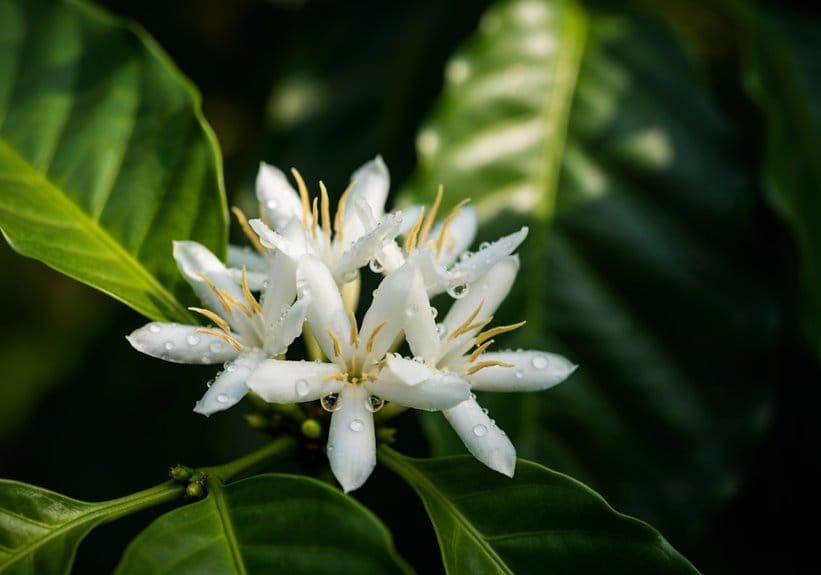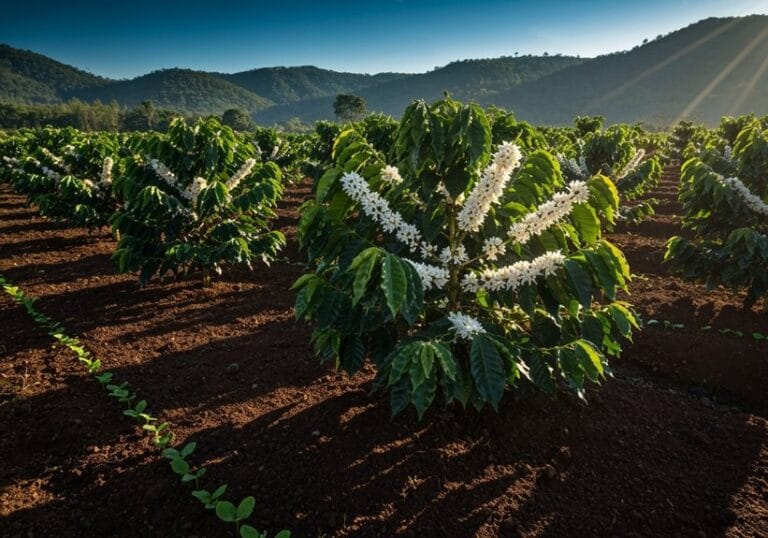During each coffee plant growth stage, there’s a lot going on! It starts with seeds germinating, which can take anywhere from a week to a month—imagine waiting for a surprise gift! Then, young plants pop up, needing shade until they’re ready for the spotlight (around six months). Fast forward to flowers budding after three to four years, only to last a couple of days, before the cherries develop from green to vibrant red—like a beauty pageant for fruits! Keep reading for insights on what to expect at each twist and turn!
Key Takeaways
- Seed germination takes 1 week to over 1 month, needing moisture and warmth for successful development.
- Young plants, after 6 months, are transplanted and require initial shade while developing roots and leaves.
- Coffee plants typically bloom after 3-4 years, with tiny, fragrant flowers lasting 1-2 days.
- Cherries develop weeks post-bloom, changing color from green to vibrant red as they ripen.
- Monitoring environmental factors and pest protection is crucial throughout all growth stages.
Seed Germination and Seedling Stage
As far as the magical journey of coffee plants is concerned, the seed germination and seedling stage is where the real adventure begins!
Envision this: coffee seeds lounging in cozy nurseries, soaking up all that hydration—yes, they totally need their spa time! In ideal conditions, germination takes a week to over a month (imagine waiting for your coffee to brew, but worse). The secret sauce? Moisture and warmth, ideally between 65°F and 77°F. To kick off this process effectively, the seed coat should be removed from each coffee seed, ensuring it can absorb water efficiently.
The initial sign of life is the radicle popping out like it’s trying to escape! This stage is essential in the coffee bean life cycle, as seedlings slowly grow roots and leaves. Spoiler alert: only fresh seeds can party—old beans? Nope, they’re just party poopers!
Young Plant Development
Young coffee plants begin an exciting journey as they shift from sheltered seedlings to robust little beings ready to take on the world! At about six months old, they’re uprooted from their cozy nursery beds and moved to the big leagues—the main plantation. But don’t just toss them into the sun! These budding beauties need a bit of shade initially, like a toddler on a sunny day—gotta protect those sensitive skin! During this time, they grow new roots and leaves, reaching around 24 inches tall within 18 months. Here’s a quick table to illustrate some key points:
| Aspect | Detail |
|---|---|
| Height after 9-18 mo | About 24 inches |
| Transplant age | Approximately 6 months |
| Importance of Shade | Protect young plants |
The journey is just starting!
Flowering Phase

In the world of coffee cultivation, the flowering phase is like that dramatic, high-stakes moment in a nail-biting movie—so much can hinge on a few small, delicate flowers!
These blooms, tiny and fragrant, pop up after about three to four years of growth, usually strutting their stuff for just a day or two. Imagine waiting patiently, only for flowers to wilt! Timing is everything, with nature playing its wild cards; in Brazil, they bloom from September to November, while in other places, March to May takes the spotlight.
The flowering phase is fleeting and vital, blooming for just a day or two after years of anticipation!
But watch out—climate chaos can shuffle those dates! Pollination is the name of the game, and good conditions mean more cherries later.
No flowers, no coffee—yikes!
Cherry Development and Maturation
While waiting for coffee cherries to develop might feel like watching paint dry, the truth is, it’s a fascinating journey filled with twists and turns! Cherries kick off their life as tiny, green little hardballs a few weeks after flowers bloom. They get busy growing, soaking up nutrients—it’s like them hitting the buffet!
Then, they go through a fashion phase, turning from green to yellow, sweetening up and hinting at their future coffee greatness. Ultimately, they ripen, turning vibrant red like they just won a fashion show!
Timing the harvest is vital, as cherries are notorious for playing hide-and-seek, maturing at different rates on the same branch. Plus, staying alert for pesky pests is part of the whole coffee drama!
Frequently Asked Questions
How Long Can a Coffee Plant Live and Remain Productive?
A coffee plant can live up to 20 to 30 years and remains productive mainly between 6 to 15 years, with gradually declining yields and quality after about 20 years of age under ideal conditions.
What Pests Commonly Affect Coffee Plants During Growth Stages?
Coffee plants face multiple pests throughout growth stages, including coffee berry borers, root-knot nematodes, aphids, and whiteflies during early stages, while fungal diseases and fruit flies threaten them during flowering and fruit ripening phases.
How Does Climate Change Impact Coffee Plant Growth Phases?
Climate change markedly disrupts coffee plant growth phases, causing accelerated development, altered flowering and fruiting patterns, increased pest and disease pressures, and greater water stress, ultimately affecting yields and quality across multiple growth stages.
What Nutrients Are Essential During Coffee Plant Development?
Critical nutrients for coffee plant development include nitrogen for growth, phosphorus for roots, potassium for fruit quality, calcium for structure, and magnesium for photosynthesis, alongside crucial micronutrients like iron, manganese, and zinc for ideal health.
How Can Coffee Farmers Improve Cherry Quality Post-Harvest?
Coffee farmers can improve cherry quality post-harvest by ensuring rapid processing, utilizing controlled fermentation, employing proper drying techniques, and carefully sorting beans to eliminate defects, ultimately enhancing flavor profiles and market value of the coffee.

